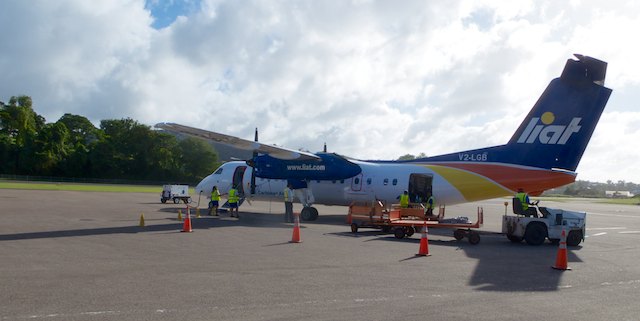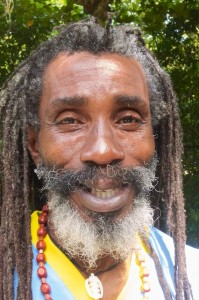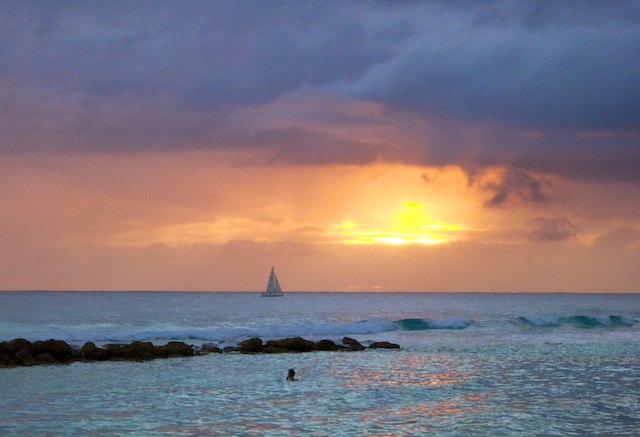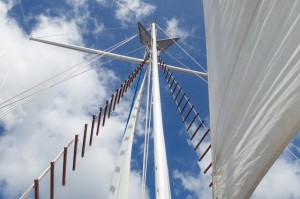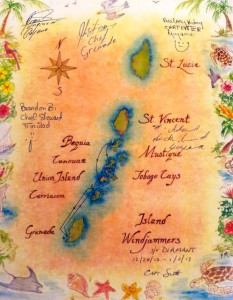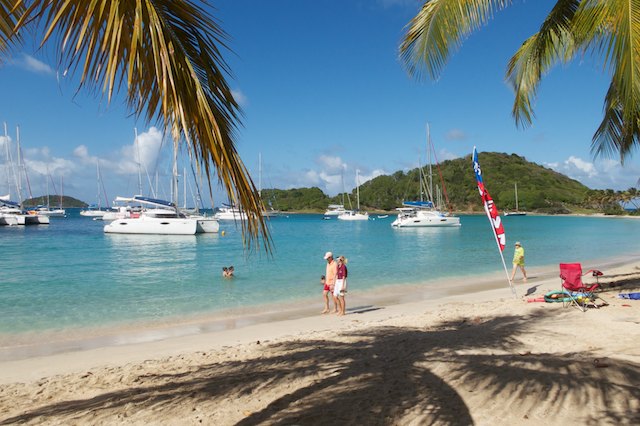Dateline: January 27
Re: The aforementioned Liat airlines. “Liat” in the native Carib language means, “Hurry up and wait, and by the way, your luggage won’t be there when you get there”.
Of course not, but you could be tempted to believe.
Having fears in Barbados that our “lost” luggage would never catch up with us while we island hopped all over the Caribbean, that it would just bounce from island to island in hot pursuit, you can imagine our relief when, (just a few hours before we had to leave for the airport by cab), our bags were delivered to our room.
I was steely eyed when we checked in for our flight to St. Lucia. There was no way in hell I was going to check my wheelie. It was going to be a carry on from that point on. The desk crew could see the madness in my eyes. That’s probably when they confessed that our bags were never lost at all. They had merely been removed before departure because apparently a large party of over-weight last minute Barbadian passengers had checked in, requiring the removal of a lot of weight in the form of passenger baggage. Seriously?
What to say, but, wtf?
Somehow (US$10.) we convinced the girls at check in that our wheelies were “carry-ons” and we proceeded to our gate where many, (many) happy hours were spent waiting for our next sky adventure on Liat Air, the very short flight from Barbados to St. Lucia.
Can I tell you, I’ve been on a number of “diverted” flights in my day. It can be disconcerting. But, I have never experienced anything like the “Day of Diversion” that this day was. Check the map for a full appreciation of this story. Barbados to St. Lucia is an incredibly short distance with nothing but a tiny bit of sea in between. When the captain comes over the PA and announces that instead of landing in Castries, on St. Lucia you will instead be doubling back to St. Vincent because your flight isn’t absolutely full, and there are a few passengers back there headed to St. Lucia – Okay, Okay, what’s one more landing and takeoff? It’s still all good, right? Because YOUR luggage is over your head and you are almost giddy with that knowledge. Now, everybody buckle up and here we go….St. Lucia! No, not quite yet. Again the captain over the P.A. Again with the announcement that we are bound for an unscheduled island. Again we get diverted. This time to Martinique. The same drill. Nobody gets off. A whole bunch of people desperate to make a connecting Virgin flight to get back to London get on. They brought with them an air of panic. That is precisely when the gentleman to our left glanced out the window only to notice that his luggage (and his golf clubs) were being removed from the back of our plane to accommodate the baggage belonging to the “limeys”. (His word, not mine. Don’t shoot the story teller.) As he was a rather fit young man, (looked like he could have been a line-backer), I might have taken his enthusiastic objections a bit more seriously if I was that flight attendant. For one tense minute I thought they would come to blows. But, in the end of those exchanges, everybody knows: the airline has the upper hand. The large, athletic looking gentleman finally capitulated, collapsed back into his seat and watched his golf clubs sadly motor back to the terminal, presumably to spend at least part of his golfing vaykay without him. I felt his pain. Pablo, on the other hand was perversely amused and I had to elbow him in the ribs when he started to laugh out loud. (Everybody knows for certainty that one would surely get thrown off a flight for clocking a member of the flight crew, but who knows what might come of passenger on passenger violence when the laughing geezeer in 14C starts smugly reporting that all of his personal effects are safely in the overhead, Sucker!)
The important thing is, (and I repeat, Liat is world renowned for the safety records of their pilots), we arrived intact (and bonus: with our all of our personal effects in hand). The airport on St. Lucia is in Castries which is about an hour’s drive north from where we stayed, up in the mountains near Soufriere. Most tourists arrive in St. Lucia on the big cruise boats to disembark for either a quickie island tour or a shopping day-trip in Castries, the largest town, pretty big as Caribbean cities go, and home to about one third of the island’s entire population.
The auto tours will take in the rustic attractions like the drive-in volcano and the national park. If you’re “off the boat” I recommend taking in one of those driving tours as the shopping in Castries is just another typical Rue du Crapola. Soufriere, on the other hand is small and quaint, without the influx from the boat to contend with. You get a much better feel for the island and her unique people there. Just outside the town of Soufriere is the Botanical garden which is worth the visit. (Guided tours are available by docents within the park, but this is not really necessary. The garden is well annotated throughout and unless you are working on your dissertation in botany, you’ll be pleased with the amount of information.
Our hotel, La Haut Plantation, was smaller than some of the really huge, much-touted resorts on St. Lucia but everything about it was superb. They offer accommodations in a broad price range, but don’t skimp. Our room (US$300/night) was possibly one of the best views we’ve ever had – in the world. Our large private deck extended out over lush tropical forest with a magnificent unobstructed and close up view of the Pitons, the twin mountains that make this place famous. The room was enormous. The owner’s house is a short walk down a dirt road and guests of the plantation are invited to swim in the big infinity pool just outside its doors in the shadow of the Pitons.
The restaurant is quite good, reasonable in price but limited in selection; the wine list is a tad short, but you WILL survive, and a few days and nights, maybe 3 is sufficient for this locale.
You can’t walk into Soufriere from La Haut, you need to take the shuttle, but the town is walk-able and interesting once you get there. If you are lucky, (we were) there will be a wedding going on in the big Catholic church in town. The celebration put me in mind of something I saw once in New Orleans and that probably is because the folks here have some of the very same cultural influences: French, African and Indo Carib. Almost everybody on the island is Roman Catholic but when you get folks talking you will find that many practice “ancient African” rituals on the side. We stopped for some liquid refreshment on our way back to the shuttle pick up and our bartender told us that you can purchase a hex for just few measly dollars, and Lord, it was mighty tempting, though I ultimately passed, fearful that the karma bus would get us on that windy road back to Castries.
They say Oprah has a home on St. Lucia and if she does she’s a smart cookie. It is unspoiled and beautiful. The people are fine company. I would say avoid Castries and the daily influx of cruisers but otherwise, this island is a gem.
Next desto: not Dominica as scheduled but instead, Antigua. But that’s another long story featuring Liat Airlines. Meanwhile, we still wish you were here.

